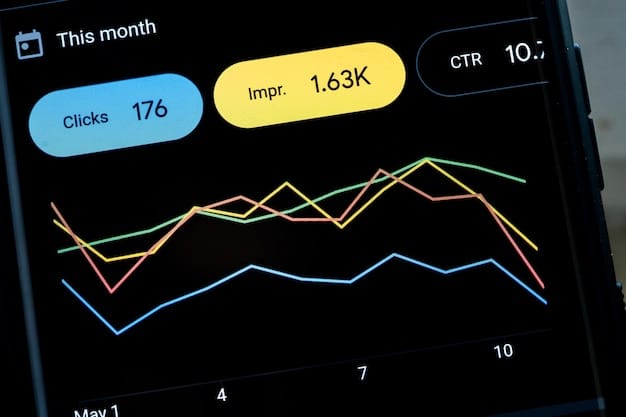YouTube Shorts Monetization in the US: A Creator’s Guide to Earning Revenue

YouTube’s Shorts monetization framework in the US provides content creators with opportunities to earn revenue from their short-form video content through advertising impressions and a creator fund, albeit with distinct eligibility criteria and payment structures compared to traditional long-form videos.
The landscape of digital content creation is constantly evolving, with short-form video emerging as a dominant format. For creators in the United States, understanding YouTube’s Shorts Monetization: Earning Revenue from Short-Form Video in the US has become crucial. This guide delves into the mechanisms, intricacies, and opportunities available for creators looking to capitalize on this popular platform.
The Rise of Shorts and Monetization’s Evolution
YouTube Shorts has rapidly grown into a significant component of the platform, challenging other short-form video giants. Its ascent has paved the way for creators to reach new audiences and, more recently, to generate income specifically from this format. This represents a pivotal shift from YouTube’s traditional long-form video monetization, offering new avenues for creators.
The initial phase of Shorts’ growth focused primarily on user acquisition and content generation. As the ecosystem matured, YouTube began exploring ways to reward creators for their contributions, recognizing the immense value short-form content brings to user engagement and platform stickiness. This evolution led to the introduction of dedicated monetization programs tailored for Shorts.
Understanding the Shorts Fund: The Initial Approach
Before the full integration of Shorts into the YouTube Partner Program (YPP), the primary method for creators to earn money from Shorts was through the YouTube Shorts Fund. This fund was a precursor to the current revenue-sharing model, designed to incentivize early adopters and high-performing Shorts creators in specific regions, including the US.
- Incentive Program: The Shorts Fund operated as a bonus program, paying eligible creators a fixed amount based on their Shorts’ performance.
- Performance Metrics: Eligibility for the fund was determined by various factors, including monthly Shorts views and audience engagement.
- Non-Recurring: Payments from the fund were not guaranteed monthly and depended on meeting specific performance thresholds that could fluctuate.
Transition to Revenue Sharing: A New Era
The most significant development in Shorts monetization has been its integration into the YouTube Partner Program. This move aligned Shorts more closely with YouTube’s established monetization model for long-form content, providing a more predictable and sustainable income stream for eligible creators.
This transition marked a strategic decision by YouTube to solidify its position in the short-form video market. By offering creators a share of ad revenue, the platform aimed to attract and retain top talent, ensuring a robust library of engaging Shorts content. The shift from a discretionary fund to a revenue-sharing model signifies YouTube’s long-term commitment to Shorts as a viable income source.
Eligibility Requirements for Shorts Monetization
Accessing Shorts monetization is not universal. Creators in the US must meet specific criteria to be eligible for the YouTube Partner Program, which is the gateway to earning revenue from their short-form videos. These requirements ensure a certain level of commitment and channel quality.
The eligibility standards for Shorts monetization within the YPP mirror some of the long-form video requirements but introduce a crucial new metric focused specifically on short-form content performance. Understanding these thresholds is the first step toward turning Shorts views into earnings.
Key Qualifications for the YouTube Partner Program (YPP)
To join the YPP and unlock Shorts monetization, creators must satisfy a combination of subscriber counts and viewership metrics. These criteria are designed to ensure creators have an established audience and consistent content output before entering the revenue-sharing scheme.
- Subscriber Count: A channel must have at least 1,000 subscribers. This foundational requirement ensures a minimum level of channel growth and community building.
- Shorts Views Threshold: Within the last 90 days, the channel must have accumulated 10 million valid public Shorts views. This is the direct gateway specifically for Shorts monetization, highlighting volume and virality.
- Watch Time (Alternative): Alternatively, creators can qualify with 4,000 valid public watch hours on long-form videos in the past 365 days, a legacy requirement demonstrating engagement across the broader YouTube platform.
Beyond Quantitative Metrics: Content Guidelines
Meeting the subscriber and view count thresholds is necessary but not sufficient. Creators must also adhere to YouTube’s comprehensive channel monetization policies, which include strict content guidelines. Failure to comply can result in delayed approval, demonetization, or even channel termination.
These policies cover various aspects, from copyright compliance to community guidelines. YouTube emphasizes the importance of original, brand-safe content that contributes positively to the platform’s ecosystem. Creators must ensure their Shorts do not violate any of these established rules to maintain monetization eligibility.
Furthermore, content quality and originality play a significant role. Shorts that primarily re-upload content from other creators or platforms, or that consist of unoriginal compilations without significant added value, may not qualify for monetization. YouTube seeks to reward genuine creativity and unique contributions to the platform.
How Shorts Monetization Works: The Revenue Sharing Model
Once a creator is accepted into the YouTube Partner Program, the mechanics of earning revenue from Shorts in the US involve a revenue-sharing model. This system differs from traditional long-form video monetization in how ad revenue is aggregated and distributed, reflecting the unique consumption patterns of short-form content.
The revenue calculations for Shorts are more complex than simply taking a percentage of ads shown directly on individual videos. Instead, YouTube pools ad revenue from across all Shorts within the Shorts Feed and then allocates a portion to creators based on their overall contribution to views within that pool.
The Ad Pool and Creator Share
Advertisements on Shorts are integrated into the Shorts Feed, appearing between videos as users swipe vertically. The revenue generated from these ads is collected into a single, shared pool. This communal approach allows for a more equitable distribution of earnings among creators, considering the rapid-fire nature of Shorts consumption.
- Revenue Aggregation: All ad revenue from the Shorts Feed is pooled together monthly.
- Music Licensing Share: A portion of this pooled revenue is first allocated to cover the costs of music licensing, as Shorts frequently use copyrighted music. This deduction ensures that artists and rightsholders are compensated.
- Creator Share Calculation: The remaining revenue is then distributed among eligible creators based on their share of total Shorts views within the entire pool, relative to other monetizing creators.
After factoring in the music licensing costs, creators receive 45% of the allocated revenue share. This 45% is a standardized rate, regardless of whether a creator uses music in their Shorts or not. The more views a creator’s monetized Shorts accumulate within the feed, the larger their proportional share of the net revenue pool.
Understanding RPM (Revenue Per Mille) for Shorts
While the traditional RPM metric (revenue per 1,000 views) still applies, its calculation for Shorts has nuances due to the pooled revenue model. Creators won’t see individual ad impressions tied to specific Shorts but rather a holistic view of their earnings based on their overall contribution to the Shorts ecosystem.
This means that simply comparing Shorts RPM to long-form video RPM can be misleading, as the underlying ad delivery and revenue distribution mechanisms are fundamentally different. Creators should focus on increasing their total Shorts views and maintaining audience engagement to maximize their share of the ad pool.
Maximizing Your Shorts Revenue in the US
Simply meeting the eligibility criteria and being part of the YPP isn’t enough; creators must strategically optimize their Shorts content to maximize their earning potential. This involves understanding audience behavior, leveraging trending topics, and maintaining consistent content quality tailored for the short-form format.

The key to higher Shorts revenue lies in generating a substantial volume of views that contribute to the collective ad pool. This necessitates a proactive approach to content creation and distribution, focusing on what resonates with the Shorts audience.
Content Strategy for High View Counts
Creating Shorts that consistently go viral or achieve high viewership is paramount. This often means embracing trends, experimenting with different formats, and understanding the fast-paced nature of the Shorts Feed. Content must grab attention instantly and provide value or entertainment within seconds.
- Hook the Viewer Immediately: The first 1-3 seconds are critical to prevent users from swiping away. Use captivating visuals, intriguing questions, or immediate action.
- Leverage Trending Audio & Hashtags: Staying current with popular sounds and relevant hashtags on Shorts can significantly increase discoverability and reach.
- Call to Action (Subtly): Encourage engagement through comments, likes, or even subtle prompts to visit your main channel for related long-form content.
- Maintain High Quality: Despite the short format, good video and audio quality enhance the viewing experience and encourage repeat views.
Beyond individual video performance, a consistent upload schedule is also vital. Regular uploads increase the cumulative view count over time and keep the channel fresh in the algorithm’s eyes. Experimentation with content types within the Shorts format is also encouraged to identify what best performs for your specific niche.
Audience Engagement and Retention
While views are a primary metric, retaining viewers throughout the entire Short and encouraging repeat views contributes significantly to overall performance and, consequently, revenue. The algorithm favors content that keeps users engaged within the Shorts Feed.
Understanding your audience through YouTube Analytics can provide invaluable insights into what type of Shorts they watch most, how long they watch, and when they are most active. This data can inform future content strategy, helping creators tailor their Shorts to their specific viewer base for maximum impact.
Engaging with comments and fostering a community around your Shorts can also drive loyalty and encourages viewers to return for more content. A strong community can become a consistent source of views and engagement, providing a stable foundation for monetization.
Challenges and Considerations for Shorts Creators
While Shorts monetization offers exciting prospects, creators should be aware of certain challenges and considerations. The unique nature of short-form video consumption and monetization means that strategies that work for long-form content may not directly translate, and there are specific hurdles to navigate.
One primary consideration is the lower RPM typically associated with Shorts compared to long-form videos. Due to the rapid consumption rate and the pooled revenue model, individual Shorts may not generate as much revenue per 1,000 views as a long-form video with mid-roll ads. This necessitates a high volume of views to achieve substantial earnings.
Lower Individual Ad Revenue Compared to Long-Form Videos
The ad placement in the Shorts Feed is designed for quick, successive viewing, often leading to a lower effective CPM (cost per mille) for advertisers and, consequently, lower individual creator revenue contributions. This means creators need significantly more Shorts views to match the earnings from fewer long-form video views.
Creators should manage their expectations regarding Shorts revenue. While it can be a valuable supplement to existing income streams, relying solely on Shorts for a full-time income might require an exceptionally high volume of viral content. It often serves better as a top-of-funnel strategy to gain subscribers who then watch long-form content.
Content Originality and Repurposing
YouTube has expressed a clear preference for original content within Shorts. Creators who simply re-upload content from other platforms (e.g., TikTok with watermarks) or create unoriginal compilations may face challenges in monetization approval or continued eligibility. The platform aims to foster a unique Shorts ecosystem.
Repurposing existing long-form content into Shorts can be effective, but it needs to be done thoughtfully. Trimming clips directly from longer videos without adding new context, editing, or creative flair might not resonate with the Shorts audience or meet YouTube’s originality standards for monetization.
Striving for unique, engaging, and platform-native Shorts content is crucial for long-term success and reliable monetization. This incentivizes creators to innovate within the short-form format rather than merely cross-posting existing material.

Beyond Ad Revenue: Alternative Earning Opportunities with Shorts
While ad revenue is the primary focus of YouTube’s Shorts monetization, creators in the US have several other avenues to generate income, leveraging their Shorts audience. These alternative strategies can significantly diversify revenue streams and build a more sustainable creator business.
The ephemeral nature of Shorts makes them powerful tools for discovery and audience acquisition. Creators can use their Shorts to funnel viewers to other platforms or content where direct monetization opportunities are more abundant or offer higher per-viewer value.
Affiliate Marketing and Brand Deals
Shorts offer a concise yet impactful way to promote products or services through affiliate links. Creators can quickly showcase items, provide mini-reviews, or demonstrate usage, then direct viewers to a link in their channel description, linked videos, or comments. Brand deals involve direct partnerships where creators are paid to integrate a product or service into their Shorts.
- Concise Promotions: Short, visually appealing demonstrations are ideal for quick product showcases.
- Link Integration: Utilizing the “related video” feature or prominent call-to-actions can guide viewers to purchase links.
- Authenticity is Key: Viewers respond best to genuine recommendations, ensuring long-term trust and converting sales.
Securing brand deals for Shorts can be lucrative. Brands are increasingly interested in leveraging popular short-form content creators to reach highly engaged audiences. Factors like niche alignment, audience demographics, and consistent engagement metrics play a significant role in attracting brand partnerships.
Merchandise Sales and Creator Support
For creators with an established brand, selling merchandise related to their channel can be a substantial income source. Shorts can serve as effective advertisements for merchandise, showcasing new designs, promoting limited editions, or simply featuring creators wearing their brand. Viewers can be directed to external store links.
Platforms like YouTube’s Super Thanks, Super Chat, and Super Stickers allow viewers to directly support creators financially. While these features are more common in Live Streams, they can still be enabled for Shorts comments, allowing engaged viewers to show appreciation through monetary contributions. This personal connection can foster a dedicated community willing to support a creator’s work.
The integration of Shopping features within Shorts is also expanding, enabling creators to tag products directly in their videos, making the purchasing process seamless for viewers. This direct-to-consumer model opens up significant e-commerce potential for creators.
Future Outlook for Shorts Monetization
The landscape of short-form video monetization is still relatively nascent and rapidly evolving. For YouTube Shorts in the US, the trend indicates continued investment and refinement of the monetization framework, aiming for a more robust and equitable system for creators.
YouTube has consistently shown a commitment to rewarding creators and maintaining its competitive edge against other short-form video platforms. This suggests that the current monetization model for Shorts is likely to see further enhancements and perhaps new features.
Potential Enhancements and New Features
It is reasonable to anticipate YouTube introducing more direct monetization tools within the Shorts ecosystem. This could include expanded shopping features, more sophisticated analytics tailored for Shorts, and perhaps even experimental ad formats that better integrate with the rapid consumption pattern.
As the platform gathers more data and feedback from creators, adjustments to the revenue-sharing percentages or the introduction of new bonus programs might also occur. The goal would be to strike a balance between compensating creators fairly and maintaining profitability for YouTube.
Furthermore, increased interactivity and direct creator-fan monetization opportunities could be on the horizon, allowing creators to engage more deeply with their audience and unlock direct financial support beyond traditional ad revenue. This could involve enhanced tipping features or exclusive content access for paid members.
The Growing Importance of Shorts in Creator Strategies
For creators, Shorts are increasingly becoming an indispensable part of their overall content strategy, not just for engagement but also for monetization. They serve as powerful discovery tools, drawing new viewers to a channel who may then convert into long-form content consumers and, eventually, loyal subscribers.
The synergistic relationship between Shorts and long-form content is becoming more evident. Shorts can tease upcoming long-form videos, showcase highlights, or offer behind-the-scenes glimpses, effectively driving traffic to higher-RPM content. This integrated approach allows creators to maximize their overall earning potential on the platform.
As the short-form video market matures, creators who effectively integrate Shorts into their broader content strategy, focusing on both direct Shorts monetization and its role in ecosystem growth, will likely be best positioned for long-term success and sustained revenue generation on YouTube.
| Key Aspect | Brief Description |
|---|---|
| 💰 Monetization Model | Revenue sharing from a pooled ad fund, 45% creator cut after music licensing. |
| ✅ Eligibility Criteria | 1K subscribers + 10M Shorts views (90 days) OR 4K watch hours on long-form. |
| 📈 Maximizing Earnings | High-volume, engaging Short content, active community; utilize trends. |
| 💡 Alternative Income | Affiliate marketing, brand deals, merchandise sales, and creator support features. |
Frequently asked questions about YouTube Shorts monetization
▼
YouTube pools all ad revenue generated from the Shorts Feed. After deducting costs for music licensing, 45% of the remaining revenue is distributed among eligible creators based on their proportion of overall Shorts views from monetized videos within that pool. This means individual video performance contributes to a larger shared payout.
▼
To monetize Shorts, US creators must be part of the YouTube Partner Program. This requires 1,000 subscribers and either 10 million valid public Shorts views in the last 90 days, or 4,000 valid public watch hours from long-form videos in the past 365 days. All content must also adhere to YouTube’s monetization policies.
▼
Generally, the RPM (Revenue Per Mille) for Shorts tends to be lower than for long-form videos due to different ad delivery and revenue distribution models. Shorts require a significantly higher volume of views to generate comparable revenue to long-form content. Creators often use Shorts for audience discovery, funneling viewers to higher-earning long-form videos.
▼
Yes, creators can use music from YouTube’s Audio Library or licensed tracks. However, a portion of the pooled ad revenue from the Shorts Feed is allocated to music licensing costs before the remaining revenue is distributed to creators. This means using popular music doesn’t prevent monetization but influences the overall revenue pool for creators.
▼
To maximize Shorts views, focus on creating highly engaging content with strong hooks in the first few seconds. Leverage trending sounds and hashtags, maintain a consistent upload schedule, and analyze your audience analytics to understand what resonates. Engaging with your community also fosters loyalty and repeat viewership, boosting your share of the revenue pool.
Conclusion
The integration of Shorts into YouTube’s monetization framework represents a significant evolution for creators in the US, offering tangible opportunities to earn revenue from short-form video. While it operates on a distinct revenue-sharing model compared to long-form content, effective strategies for content creation, audience engagement, and diversification of income streams can lead to substantial and sustainable earnings. As the platform continues to refine its approaches, creators who adapt and innovate within the Shorts ecosystem will be best positioned to thrive.





